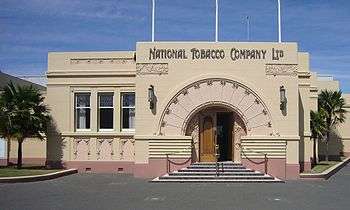Smoking in New Zealand
The use of tobacco for smoking in New Zealand has been subjected to government regulation for a number of decades. On 10 December 2004, New Zealand became the third country in the world to make all indoor workplaces including bars and restaurants smoke-free.
| Part of a series on |
| Tobacco |
|---|
 |
| History |
| Chemistry |
| Biology |
| Personal and social impact |
| Production |
Consumption
The number of cigarettes available for consumption, a statistical measure that reflects sales, has generally been decreasing since they peaked at 6.3 billion in 1977 but consumption has remained constant from 2005 through to 2008 at 2.4 billion cigarettes. Over the last 30 years the number of cigarettes that have been available has dropped by 61.5%. The volume of tobacco available for consumption rose to a new high of 904 tonnes and was 83.3 percent higher than the lowest amount recorded in 1985.[1]
Legislation
The first building in the world to have a smoke-free policy was the Old Government Building in Wellington, New Zealand, in 1876. This policy was enacted over concerns about the threat of fire, as it was the second largest wooden building in the world.[2]
The earliest attempt at tobacco control was in 1907, when the government moved to ban tobacco sales to persons under the age of 16, as it was feared that tobacco would "stunt" a minor's growth. However, this law was not enforced until 1988. In 1997, the age restriction was increased to 18 years. Although it is now illegal to sell tobacco products to a minor, a minor may still publicly consume, possess and distribute tobacco to friends without penalty (as opposed to alcohol).
The Smoke-free Environments Act 1990 was passed to prevent the effects of passive smoking on other people by restricting cigarette smoking in places such as workplaces and schools.[3]
New Zealand passed an amendment to the Smoke-free Environments Act on 3 December 2003 (effective in 2004) which covers all indoor public workplaces and hospitality venues (pubs, bars, nightclubs, charter club bars, restaurants and casinos). Studies have shown very high levels of compliance with the law. Also, the air quality at indoor hospitality venues is very good compared to similar settings in other countries where smoking is still permitted.[4]
Outdoor smoke-free laws cover the grounds of all schools, some council-owned parks (e.g., in South Taranaki and Upper Hutt), the grounds of some hospitals, stadiums and most university campuses. However, these laws are not strictly enforced apart from a polite request from security guards and property owners. The government has not moved to restrict smoking in cars, but has run mass media campaigns that promote smoke-free cars and homes.
Smoking on domestic flights was banned in 1988 and on all international flights as of 1996.
Cigarette advertising was banned on TV and radio in 1963, on cinemas and billboards in 1971, and in print media in 1990. Tobacco sponsorship was phased out in 1995 and tobacco signage banned from outside shops the same year. Tobacco displays themselves were banned in 2012.[5]
The sale of single cigarettes was banned in early 1998, and cigarettes are required to be sold in packs of no less than 20.
The New Zealand government's National Drug Policy 2007-2012 seeks to reduce the effects of tobacco use by limiting availability, limiting the use of tobacco, and reducing harm from existing tobacco use.[6]
Lobbying

On 5 September 2007, Action on Smoking and Health (ASH) called for the removal of tobacco from sale by 2017.[7] Tobacco displays in shops were banned in 2012.[8] Winston Peters, himself a smoker, has long been lobbying for the rights of smokers. In the 2016 New Zealand budget, ACT New Zealand also came out lobbying on behalf of smokers, arguing that although tax on tobacco had doubled in the last five years, smoking rates had only dropped by 1.3 percent.[9]
See also
- Cannabis in New Zealand
- Anti-smoking movement
- Health effects of tobacco smoking
- Smoke-free Environments Act 1990
- Tobacco company
- Tobacco industry
References
- "Alcohol and Tobacco Available for Consumption: Year ended December 2007" (PDF). Statistics New Zealand. 22 February 2008. Archived from the original (PDF) on 19 November 2008. Retrieved 17 September 2008.
- Department of Conservation
- "Smoke-free Environments Act 1990 No 108 (as at 04 April 2016), Public Act Contents – New Zealand Legislation". legislation.govt.nz.
- "Smokefree law". moh.govt.nz.
- "Plain packets to follow tobacco display ban". 3 News NZ. 23 July 2012.
- Ministerial Committee on Drug Policy (March 2007). National Drug Policy 2007-2012. Wellington: Ministry of Health. ISBN 978-0-478-30751-1.
- "ASH - Action on Smoking and Health New Zealand". ash.org.nz. Archived from the original on 10 June 2009.
- "ASH backing tobacco display ban". 3 News NZ. 23 July 2012.
- "ACT on side of working class over fags tax rise". The Press. 31 May 2016. p. A2.
Further reading
- Thomson, George; Wellington School of Medicine. The tobacco industry in New Zealand: a case study of the behaviour of multinational companies. Public health monograph series. Wellington, N.Z: Dept. of Public Health, Wellington School of Medicine and Health Sciences. ISBN 0473084155.
External links
- Ministry of Health - Tobacco Control and Smoking page
- National Drug Policy New Zealand
- Ministry of Health - links to lobby groups and stop smoking groups
- - Quitline NZ
.jpg)
.jpg)